#animal husbandry
Explore tagged Tumblr posts
Text
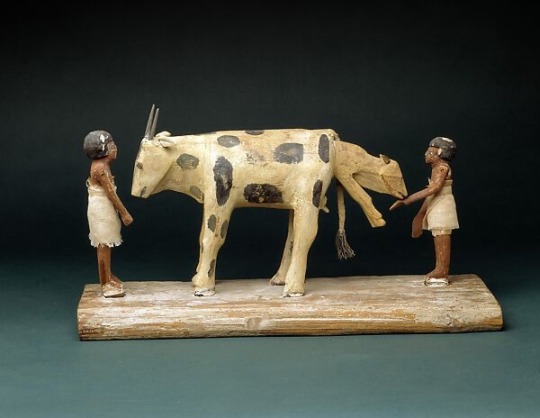
I can’t tell you how much I love this artwork from ancient Egypt (the Middle Kingdom). People have been raising cattle and practicing animal husbandry for so long, that there is something almost inherently human about this scene.
Everyone in the field of veterinary medicine or agriculture knows the feeling of staying up late with a laboring animal trying to make sure both mom and baby are okay. Delivering a calf is often physically and emotionally exhausting work that takes enormous patience and learned skill. It requires a unique balance of physical strength and gentleness to do correctly. There is no feeling quite like getting that baby out and everyone is okay. I’m certain ancient people must have felt the same way, and I wonder if the artist knew this feeling firsthand. I wonder if those humans depicted were people the artist knew, if the cow and calf maybe were as well.
28K notes
·
View notes
Text

From the Rattlecam project- "The first baby garter snake has arrived at the den! It immediately found the perfect pillow."

More rattlesnake snuggles, from the same location.
I know a lot of the time in captive care settings, we warn keepers that their snakes aren't cuddling- that they're competing for resources. And I'm of the opinion that for the vast majority of captive snakes, they don't benefit from prolonged, enforced conspecific contact.
But it's fascinating to watch these rattlesnake cams because rattlesnakes do benefit from prolonged conspecific contact. Rattlesnakes den together, and several of them are highly social species. If I was designing an exhibit for rattlesnakes, I'd certainly put more than one animal in there, because when you observe them in the wild they spend so much time together- which we didn't know until we started setting up cameras to observe them. It just goes to show that you really need to pay attention to the particular needs of individual species. What's good for rattlers and garters isn't necessarily good for ball pythons and cornsnakes.
790 notes
·
View notes
Text
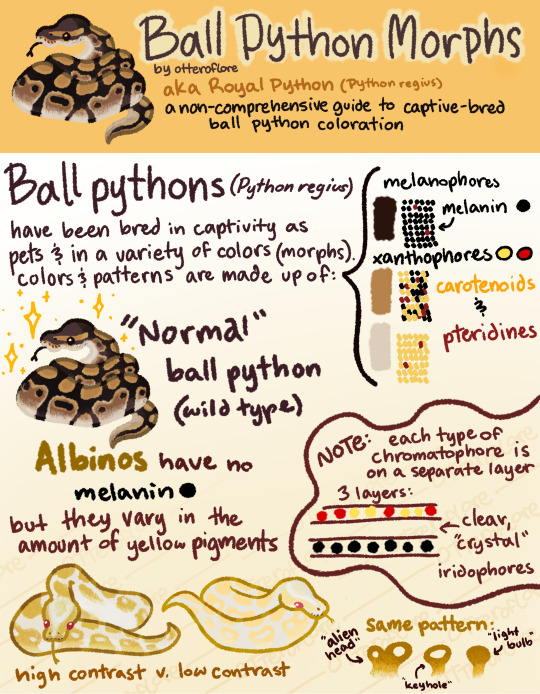
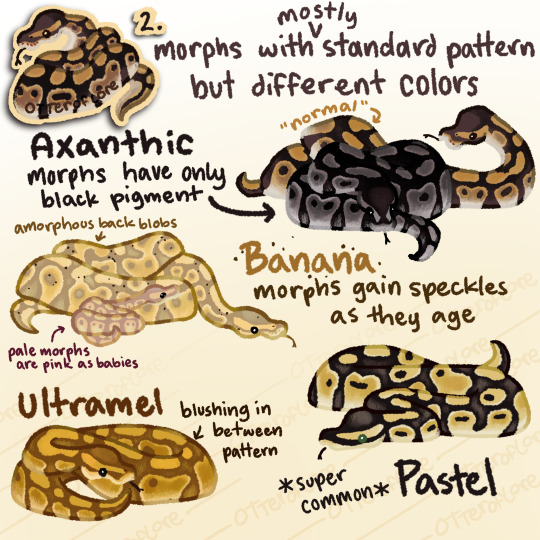

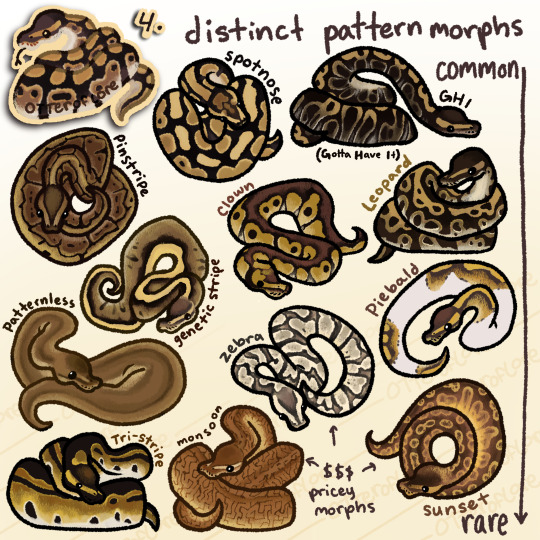
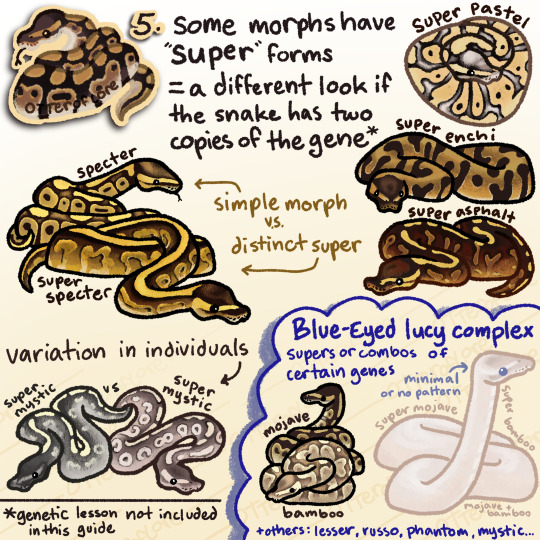
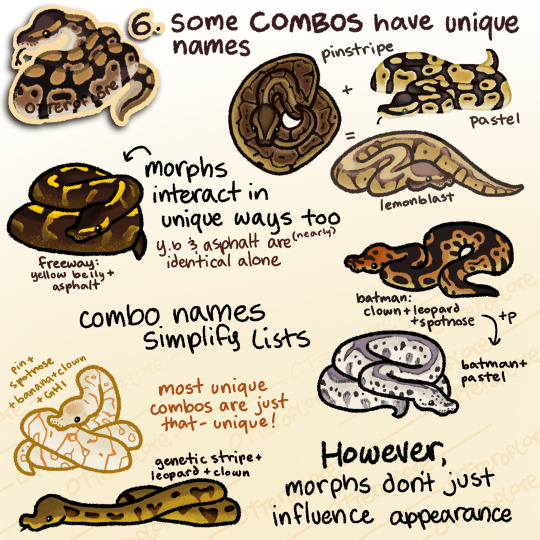
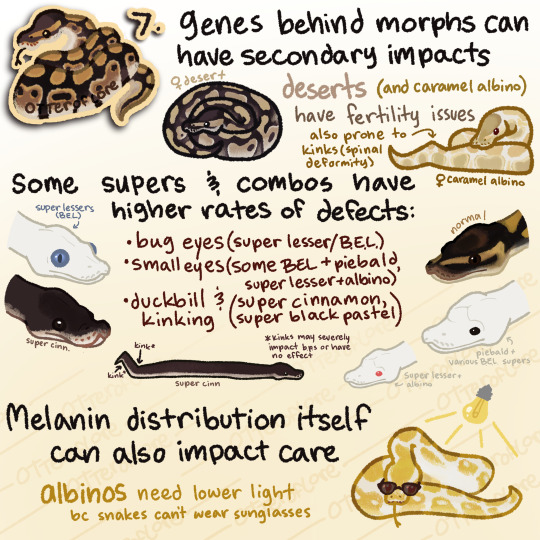
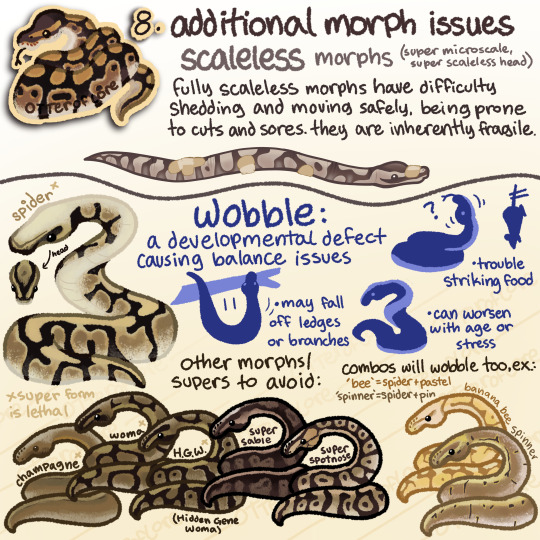
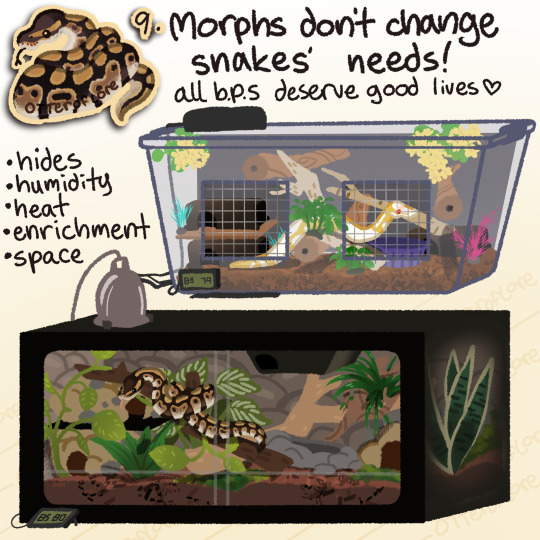
science sources (x, x, x, x, x, x, x, x) other (x)
This snake morph guide is just meant to explain some basics of morphs. I would caution anyone in buying a pet that takes a high level of care just because it's pretty, and frankly any breeder that continues to breed morphs with physiological and neurological defects should be put out of business. I did my best as I find this interesting and believe there's a lot of misinformation out there due to people trying to literally sell things to their audience.
I included some links if you would like additional reading. They range from a study on captive care management, studies I could find relevant to the severe issue morphs, and some general on snake color and scales.
6K notes
·
View notes
Note
I love Fiona the Hippo, so I really liked your post highlighting her, but now I'm sad that Moo Deng is having a bad time. I did think it was funny she tried to bite that one handler's crotch, and I was worried that she's going to grow up to be an aggressive hippo that might hurt someone because they're just kinda . . . letting her bite people and how that'll end very badly for her, but it hadn't occurred to me that she was being mistreated. :(
It’s hard to say whether she’s being “mistreated” necessarily. I don’t like to throw around words like abuse when it comes to animal welfare because people use it way too lightly.
But there’s definitely a degree of stress she’s experiencing due to that handling. It’s so easy to find cute animal videos endearing and amusing when we don’t know what to look for.
I tend to try to assess things over multiple contexts and videos and form an opinion from there. The blatant smacking, grabbing, picking up and chasing were probably the best examples- but I only found most of those because TikTok kept shoving guest videos from the zoo onto my fyp.
The biting was another flag. Yes, hippos use their mouths to interact with their world but regardless of context it’s just a huge no no when it comes to handling any animal - especially a large herbivore that grows up with a bite force of approx 1800lbs!
Also I was looking for more videos of their adult Pygmy hippos and came across a video of one of the keepers using a water gun on one of them

Dude really? You’re going to post that on your official zoo TikTok and not have a think about the optics for your conservation message?
Yikes.
Also the adult Pygmy hippo very much avoids the keeper and either tolerates it or runs away from the water.
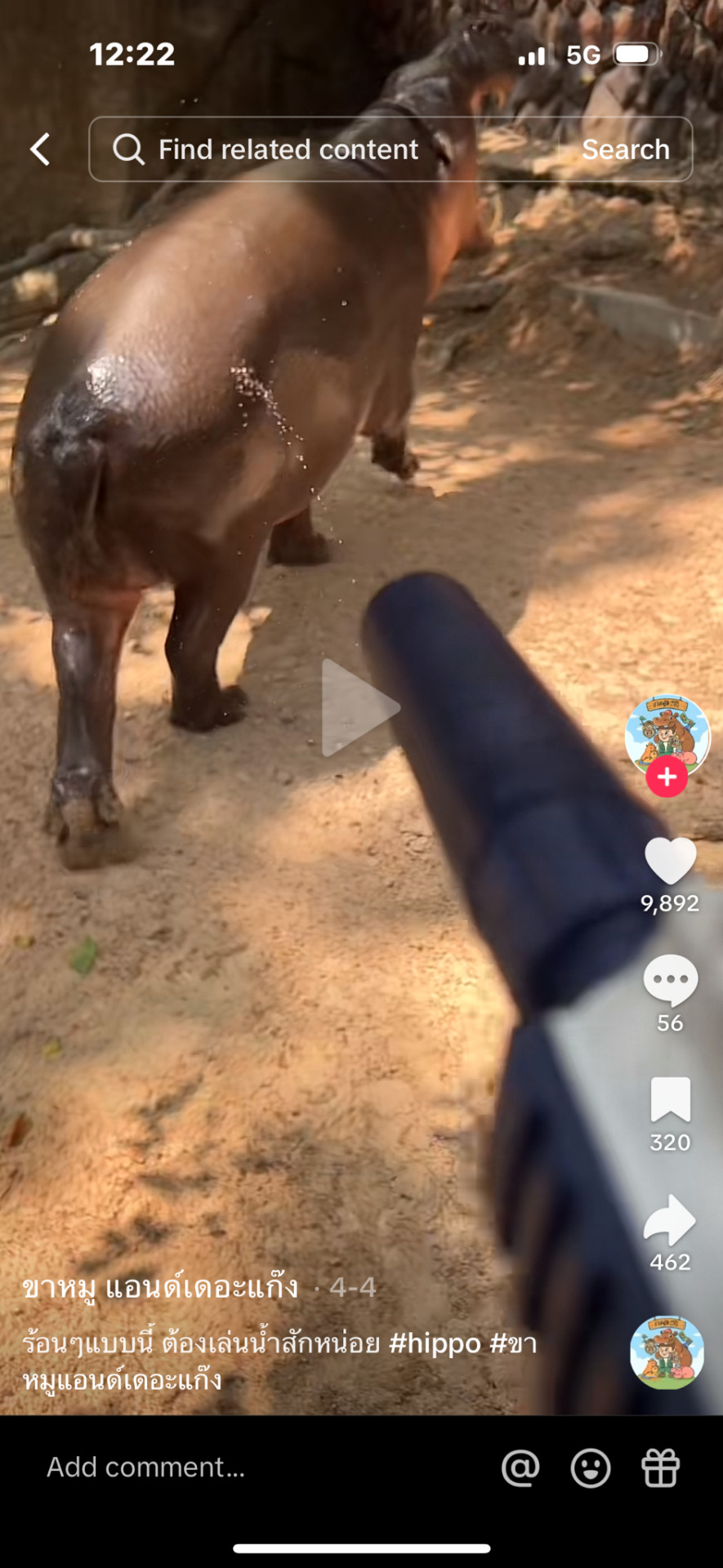
Interesting to see the open mouth while being followed/chased with the water gun while he tries to avoid it. A redirected threat display? A stress yawn? He just looks very much like he’s tolerating it.
It does make me wonder if this is another hippo raised with the same rough handling as Moo Deng and they’ve just learned nothing they do matters and to tolerate whatever comes their way. It’s pretty much learned helplessness and I don’t like that at all.
Compare this with Fritz the common hippo (Fiona’s brother) interacting with the hose - it stays in one place for him to interact with, is offered and then moved away so he can continue to seek it out if he wants more. He actively seeks the hose and can move himself around to where it feels best.
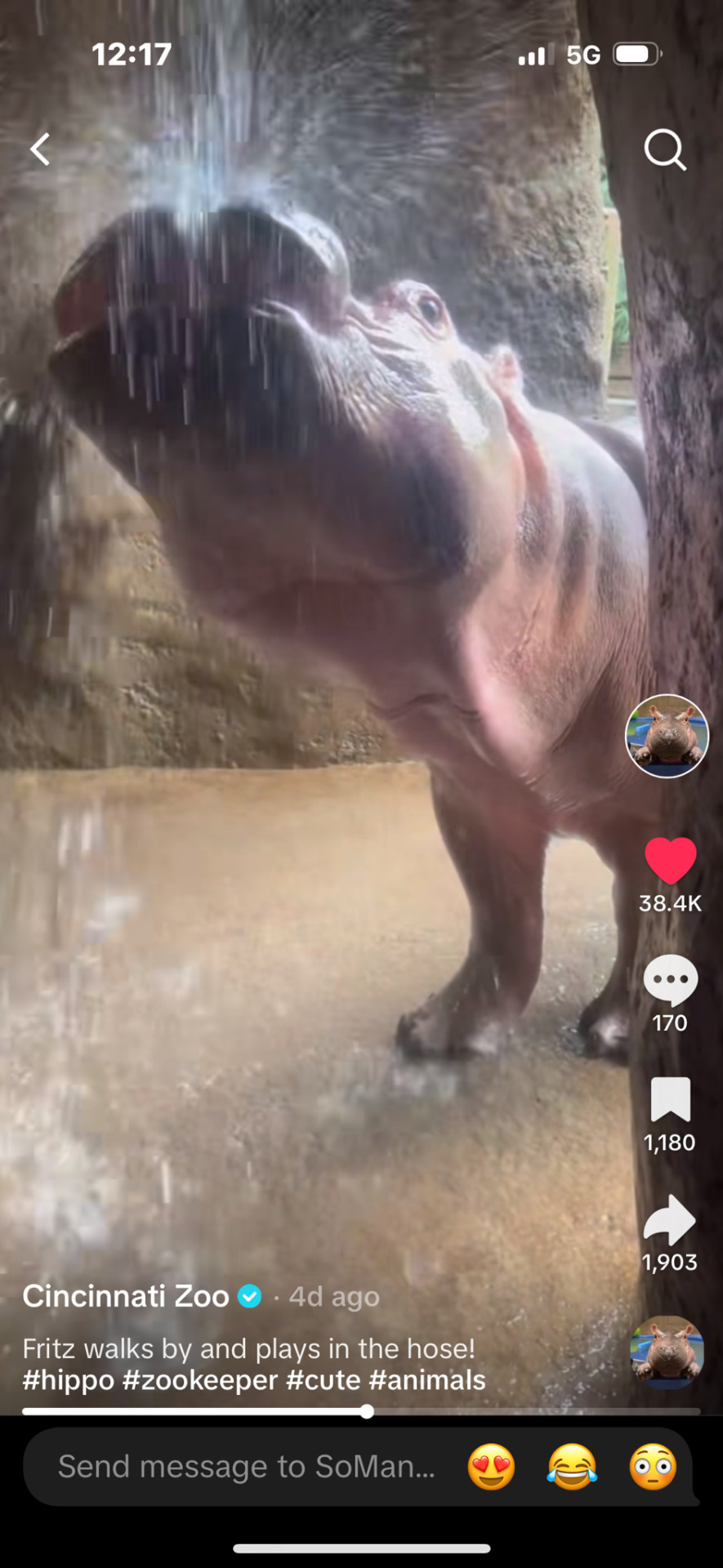
This is how you offer consent and autonomy to your zoo animals. Not chase them around their enclosure with a water gun jfc
#animal welfare#zoo animal welfare#pygmy hippo#animal husbandry#animal enrichment#or lack thereof#I’m so baffled by the water gun though what the actual fuck dude#Moo Deng
269 notes
·
View notes
Text
Today I got to visit the Georgia Aquarium and do a little behind-the-scenes tour! This aquarist has the awesome task of feeding one of the resident whale sharks - no easy task, but they've employed a pretty ingenious track system of lines strung across the surface by which aquarists can pull themselves across on inflatable boats to keep ahead of one of the ocean's largest filter feeders!
#georgia aquarium#marine biology#aquarist#whale shark#zoology#animal husbandry#marine bio#marine biology studyblr#marine bio studyblr#biology#marine life#animals#nature#aquarium#conservation#ecology#marine conservation
191 notes
·
View notes
Note
https://archive.is/LAwFB <- Here is a link to a 2023 National Geographic article about horse slaughter in the Americas. You might be interested to know that thoroughbreds actually make up only 10% of horses exported for slaughter. The vast majority of retired racehorses in the US and the UK that aren't kept for breeding purposes go on to second careers or are simply kept as companion animals. This is *NOT* to say that the racing industry doesn't have horrific problems, but rather that even when they don't succeed on the racetrack, the horses are still worth more alive than they are as food. Quarter horses, on the other hand...YEESH. Let's just say the Jockey Club keeps meticulous track of how many thoroughbreds are foaled every year. The AQHA...doesn't.
for context this ask is referring to this post i made yesterday
i have much to say on this and ended up just rambling about horse which i love to do when given an intriguing ask so here we go
punctuation and capitalization usage for ease of understanding GO!
sorry if this makes no sense i just went crazy and hate proofreading
Thoroughbreds are not the only racehorse, their racing is just the most popular kind in the States. Quarter horses are actually a bit faster than thoroughbreds, but that makes their races quicker and less entertaining to rich betters. Standardbreds and arabians are also popular racers, but standardbreds are used more in harness racing, and arabians for endurance.
"Pinhooking" is a popular thing in horse racing. According to horseologyinc.com, "Pinhooking is a fancy term that describes the practice of buying a horse at one stage of development and selling them at the next." This makes it difficult to track every single horse's purchase history, because there are just so many transactions being made. The Jockey Club can track births, sure, and it can do its best to track deaths, but the births of potential successful racehorses are much more interesting to the organization than the deaths of former ones. Even if deaths were monitored with the same vigor, horses would slip through the cracks, and oh brother, they already do. It's impossible to expect an organization that facilitates the often-fatal exploitation of horses to be stalwart advocates of its victims' aftercare. Even if they witnessed the slaughter of thoroughbreds in Canadian slaughterhouses, what's the difference between a horse that died for meat and a horse that died for the entertainment of the bourgeoisie? They both end up dead, and the Jockey Club doesn't deal in dead horses, it deals in eventually dead horses.
Many racehorses are later sold out of the industry once they've served their two potential purposes: racing and breeding. Once a horse is sold to a private owner that isn't involved in the racing industry—including the Amish, who often buy ex-racers as work animals—the Jockey Club's influence, if there is any, can falter. Sure, some are treated with a lavish retirement at Old Friends or Akindale or even Puerto Rico, but many, many horses do not have that privilege. Horses do not have the pull (pun intended) they once did in American society. They are a luxury to most, as their cost of upkeep and maintenance often outweighs their function when compared to machinery that performs similar jobs. Kill buyers—those who buy horses in bulk to export for slaughter—buy horses private owners either cannot or do not want to keep investing in their companion. More often than not, they don't register their purchase of horses for slaughter with the Jockey Club, nor really with anyone, as laws surrounding horse slaughter and export are murky at best and nonexistent at worst. I want to provide you more evidence of this, but the Jockey Club's website keeps timing out for me, so I'll try later.
USA Today estimates that 7500 thoroughbreds are slaughtered for meat each year. When compared to the 57000 total horses slaughtered annually, this resembles the 10% number you gave me. Compare this to the 600 thoroughbreds estimated to die each year in race-related accidents. The racing industry is constantly criticized for its mistreatment of its horses and the deadliness of its sport, and yet, slaughter claims over 12 times the amount of thoroughbreds each year—likely more. I personally believe that it is very unlikely that kill buyers accurately judge the breeds of the horses they slaughter. These buyers process thousands of horses each year and transport them in large quantities. They do not care what breed the horses they process are. It's the meat that matters. Similarly, these kill buyers are not checking the lip of every horse they buy to see if it's a former racer. Some might, if they're looking to "ransom" some of their horses off—sell the horses to non-slaughterhouse buyers for much higher than the ~60 cents/pound they get for their meat—but it's unlikely. Mike McBarron, a long-time kill buyer in Texas, told USA Today Sports, "It’s just a job to me. I mean, I don’t attach myself to them." He went on to say that he has "bought and sold retired racehorses for slaughter [and] sent tens of thousands of horses to slaughter plants," generating "millions of dollars in revenue." To kill buyers like McBarron, these horses are products to be processed and shipped, not beings whose personalities and histories are meant to be known, or whose breeds are significant to their new function: becoming meat.
And this is just thoroughbreds. Quarter horses are the most popular breed of horse in the U.S., and, like you said, there's even less regulation of the sales of other breeds. I just think it's unfair to say that the Jockey Club cares enough about its horses that they don't end up in slaughterhouses.
By the way, I don't think it is morally wrong to eat horses. Cows, pigs, goats, sheep, chickens, and other livestock animals can have just as much personality as your average horse and are not afforded the public outcry horses receive when it comes to their slaughter. Horse lives are not worth more than other "farm" animals just because they are viewed as companion animals while the rest are not. I instead have a problem with the fact that horses used for meat are often severely mistreated, just as they are in the racing industry. Regulations have been put in place to improve the lives of many meat animals, and yet, the government largely shuffles its feet when it comes to regulating the production of horse meat. This encourages kill buyers to do shady business and mistreat their animals, exploiting a loophole in the government's weak implication of a ban on horse meat: in their 2006 budget, U.S. Congress decided to simply forbid the USDA (United States Department of Agriculture) from using taxpayers' money to inspect horse slaughter plants. This sort of banned horse slaughter by preventing horse slaughter plants from being USDA inspected or approved, making them functionally illegal, as they require regulation, but meant that kill buyers could instead simply collect horses and then sell them to slaughterhouses in Mexico and Canada for slaughter. This encourages a shitty, shady business of horse exportation, leading to horrible temporary holding conditions as horses wait to be transported across country borders in equally horrible trucks and trailers. If the industry was legal and faced the same regulations as other types of meat production, these horses would have much better lives. Though I am very aware of the many, many flaws of the meat industry, denying horses even those basic protections that are applied to meat animals, especially large ones like cows, only encourages abuse and mistreatment. Big advancements in animal welfare in the meat industry have been made in the past few decades, and it is not the ethical win many think it is to force horses to live in horrible, barely-legal conditions because it is hard to accept the facts that:
Horses are large, hard-to-care-for animals whose main function in American society has mostly become obsolete
Even in their current major societal role, racing, they face massive amounts of abuse and mistreatment
There are a LOT of horses in the world (so many, in fact, that they sometimes become pests or invasive species)
Every single horse will not have the privilege of a forever home that can provide for them the utmost care
Some horses can live satisfactory lives as PROPERLY CARED FOR meat animals if given the chance
Horse meat is a valid, valued food source for many people
I know it's crazy for The Horse Blog to say they support horse meat production and consumption, but honestly, I've tried my best to express on this blog that no being is greater than another and all things deserve equal love and appreciation. It would be hypocritical of me to condemn horse meat consumption when I myself eat the meat of cows, pigs, and chickens, who are just as valuable as horses in the grand scheme of the universe. All living things have value that is not contingent on their perceived purpose or use. Meat consumption is a necessity for many in the world, both human and inhuman, and the consumption of meat on its own is not unethical. To live is to consume, be it meat, vegetation, oxygen, water, time, space, etc. and I believe that we should strive not to abhor consumption but do it ethically, in alignment with our world's fragile, functional balance of creation and destruction, and with utmost respect for that which we consume. Horses deserve that respect.
anyway yeah feel free to engage with me on this i like discussing stuff like this and spent way too long thinking and researching and stuff
Sources: "Horses go from racetracks to slaughterhouses: 'It's just a job to me'" by Josh Peter with USA Today
"Horse racing deaths mount as states spend billions to keep tracks alive" by Frank Esposito and Stephen Edelson with USA Today Network
"What is Pinhooking? The History and Practice of Pinhooking." from horseologyinc.com
"Horse Racing Fact Sheet" from fundforhorses.org
ps this wasnt made as an attack on you anon or anything i like to write horse essay style posts sometimes like this and this because its honestly super fun for me and i love receiving these types of asks i am always happy to talk about horse stuff at length like this because i end up learning a lot about these subjects too as i go
#dischorse#ask#horseimagebarn#horseimagebarn talking#horse#horses#horseblr#horseposting#equine#meat industry#horse racing#thoroughbred#racehorse#usa#meat production#horse community#horse meat#meat consumption#meat#equestrian#long post#usa centric#usda#agriculture#animal husbandry
80 notes
·
View notes
Text
Though they much resemble the domesticated gadget, devices are wild creatures, and cannot ethically be kept in the home. Where careless gadget husbandry has allowed abandoned and escaped specimens to breed with the local device population, the resulting feral crossbreed is known as a contraption; while there have been some reports of contraptions successfully being kept as pets, high-device-content contraptions are often destructive and invariably have high maintenance needs, and should thus be considered for experts only.
2K notes
·
View notes
Text

Making good on my word, here’s a very simple explanation of moon spotting ft. A photo of my friends goat, Roman who was very dappled!

47 notes
·
View notes
Text

The face. It just slays me.
Crozier, William, and Peter Henderson. How the Farm Pays the Experiences of Forty Years of Successful Farming and Gardening William Crozier, Peter Henderson. 1st ed., Peter Henderson and Co., 1884.
Source: Internet Archive
65 notes
·
View notes
Text
your steed will not eat you or throw you off, but they WILL demand respect, and you don't want to know what happens when you don't give it. If you do, they'll be your best friend. So... which one?
yes, you are responsible for housing, feeding, cleaning, and enrichment, but you already have the resources, otherwise you wouldn't be getting the animal.
688 notes
·
View notes
Text


me when i get u
18 notes
·
View notes
Note
Hey, idk if you'd know this or not, but I've watch multiple zoo shows where they have a wild equine of some sort and to trim their hooves they always use a tranquilizer gun to put them out completely.
My question is why they don't train them to get hoof trims, with maybe some more minor sedition if needed like domestic horses do? I get that they are wild, but they have trained the giraffes to stand for foot care (at least this one zoo did), so idk why a zebra can't be taught that too. Especially when full sedation is so hard on the body and they're always concerned about them being down to long.
Is it because they don't want to habituate them to humans to much, or is it for safety of the person doing the hoof care? Are full hoof trims just to invasive of a procedure to train these wild equines to tolerate? Mix of all of these?
Really good question! So some zoos do train voluntary hoof trims but it depends on how many zebras are in your herd and how many staff you have.
youtube
This is a nice example of hoof trim training being used with a younger zebra, so they have the added benefit of early socialisation and habituation to people.
Also if you have your zebras out in a massive plains habitat, you'll need to be able to train them to come into a smaller area or recall to a station if you need to do husbandry. And
Ungulate keepers can be spread out across multiple species (though it depends on the zoo - that was the case at the zoo I did my zoo keeping course at) and their time is very limited to what they can acheive in that day. And it can also depend on the skill and experience - if no one on the team has experience in cooperative care it can be hard to get a cooperative care training plan going.
My experience has been that a lot of training and enrichment programs will take a backseat over general husbandry/cleaning and paperwork. And it sucks because training and enrichment are so vital to enhancing the welfare of your animals and sometimes upper management just doesn't get that.
So if a facility doesn't have the time, staff and resources to put towards training each individual zebra for a voluntary hoof trim (which could take months), sedation is the next best thing to ensure safety for the keepers and the animals. The stress for a wild flight animal is just going to be way too much for them and they will still need their hooves trimmed regardless.
The risk of complications around overgrown hooves or issues related to hooves are massive, so that has to be weighed against the effects of anesthesia.
As zoo keeping and cooperative care training advances, I've seen some really promising ideas about habitat design encouraging more movement on different substrates resulting in more natural hoof wear. Diet would be another consideration if we wanted to limit excessive hoof growth.
Would love if any ungulate keepers wanted to chime in with any thoughts!
This is a neat little video about why zebras need their hooves trimmed in human care:
youtube
Thanks for the question!
87 notes
·
View notes
Text
I recently started taking care of penguins and I feel like I need to get a shirt for when I run errands after work that says “I smell like this because I work with penguins, not because I have a raging yeast infection.”
17 notes
·
View notes
Text
Researchers report that replacing 50% of animal products with alternative proteins by 2050 could free up enough agricultural land to generate renewable energy equivalent in volume to today's coal-generated power while simultaneously removing substantial CO2 from the atmosphere. The study, published in the journal One Earth, is based on a CO2-removal method known as "bioenergy with carbon capture and storage" (BECCS), which involves cultivating quickly growing crops whose biomass can then be stored permanently in geological formations or used as a feedstock to produce renewable energy.
Continue Reading.
#Science#Enviroment#Earth Science#Animal Husbandry#Carbon Emissions#Carbon Capture#Climate Change#Diet
105 notes
·
View notes
Text








My zine, "how to care your spider" (: It's about how to care your spider
#bugs#spider#zine#husbandry#animal husbandry#sorry real spider caretakers i hope you get a chuckle out of this at least LOL#this is inspired by the time i spent digging thru care guides to take ULTIMATE CARE OF MY PETS#wanted to do a silly version
13 notes
·
View notes
Text
Well everyone, I performed my first ever cetacean ultrasound today!
My “patient” is in excellent health, and this session was meant merely as practice both for me and for her—ensuring she remains comfortable holding still for scans. Because whales and dolphins are too big for manual palpation or x-rays, ultrasound is how veterinarians visualize their internal organs and ensure they remain healthy. Cetaceans in human care routinely receive ultrasound scans to monitor their health, even if they are not ill or pregnant.
And it’s a great example of cooperative care! Unlike dogs and cats, which have to be sedated or manually restrained by humans in order to get diagnostic ultrasound images, cetaceans in human care are trained to float in place while the veterinarian places the ultrasound probe on them. They are free to leave the session at any time. And there’s no need for ultrasound gel, because the water acts in its place!
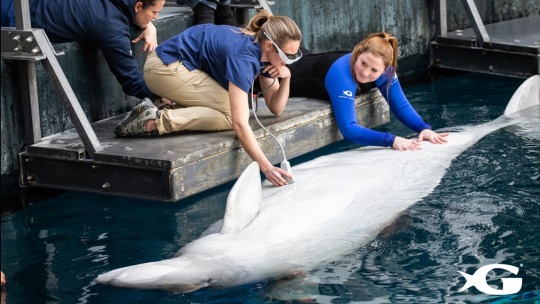
(Photo not of me… published by Georgia Aquarium when their beluga Whisper was pregnant with her calf Shila)
All in all, a great end to my externship!
#very sad to leave… but I’m heading directly to my next externship tomorrow!#another aza facility with cetaceans#my third and final externship will actually be right after I graduate because I couldn’t fit it into my clinical year#whales#dolphins#belugas#orcas#cetaceans#marine mammals#animal training#animal husbandry#vet med#zoo med#aquatic med#vet school#vet student#externships
97 notes
·
View notes